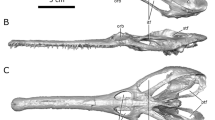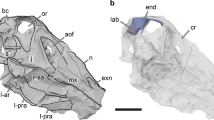Abstract
IX,—On the Nomenclature of the Brain and its Cavities IN working at the brain of the lower Vertebrata, the inconvenience of the received terminology of the cerebral cavities became so manifest, that I adopted the plan1 of distinguishing each cavity by the simple expedient of placing before the syllable cæle (κο?λος, κοιλία) the prefix used for the corresponding division of the brain in the systematic nomenclature adopted in Quain's “Anatomy.” Thus, the entire cavity of the mid-brain of fishes, for which the usual names “aqueduct of Sylvius” or “iter a tertio ad quartum ventriculum” were unsuitable, became the mesocæle or cavity of the mesencephalon, the “lateral ventricles,” the prosocæles or cavities of the prosencephala, and so on. A similar but more thorough-going reform had been previously and independently proposed by Burt Wilder (Science, ii., 1881, pp. 122 and 133), and adopted in Wilder and Gage's “Anatomical Technology” (New York, 1882). Prof. Wilder was good enough to write to me on the subject, and, after some correspondence had passed between us, he published an article2 giving a full account of the nomenclature he proposed to adopt, and stating that certain of his terms (e.g. neurocæle for the entire cavity of the cerebro-spinal axis, and encephalocæle for the entire system of brain-cavities) had been proposed by me.
This is a preview of subscription content, access via your institution
Access options
Subscribe to this journal
Receive 51 print issues and online access
$199.00 per year
only $3.90 per issue
Buy this article
- Purchase on Springer Link
- Instant access to full article PDF
Prices may be subject to local taxes which are calculated during checkout
Similar content being viewed by others
References
"Notes on the Anatomy and Embryology of Scymnus lichia," Trans. N.Z. Inst. xv. (1882), p. 222; "A Course of Instruction in Zootomy," London, 1884.
" Encephalic Nomenclature," Neu York Medical Journal, xli. (1885), pp. 325 and 354.
" Suggestions on some Points of Anatomical Nomenclatur" Journ. of Anat. and Phys., xii. (1878), p. 154.
" Critics will no doubt object to using an adjective as a substantive, but how far this is admissible is entirely a matter of usage," &c. (Pye-Smith, loc. cit., p. 174, note).
Cerebellum is one of the few names in the older brain-nomenclature which presents no ambiguity, so that the only reason for giving it a Greek synonym is the logical satisfaction of having a similar set of names for all the great divisions of the brain. Strictly speaking, the word epencephalon, being synonymous with cerebellar segment, ought not to be used for the cerebellum itself, and hyperencephalon might be used instead, with hyperoc" le for cerebellar ventricle.
Author information
Authors and Affiliations
Rights and permissions
About this article
Cite this article
PARKER, T. Notes from the Otago University Museum . Nature 35, 208–210 (1886). https://doi.org/10.1038/035208a0
Issue Date:
DOI: https://doi.org/10.1038/035208a0
Comments
By submitting a comment you agree to abide by our Terms and Community Guidelines. If you find something abusive or that does not comply with our terms or guidelines please flag it as inappropriate.



